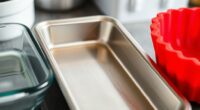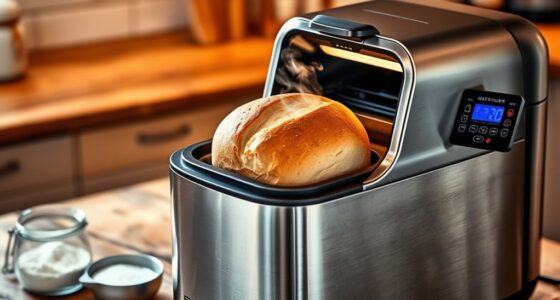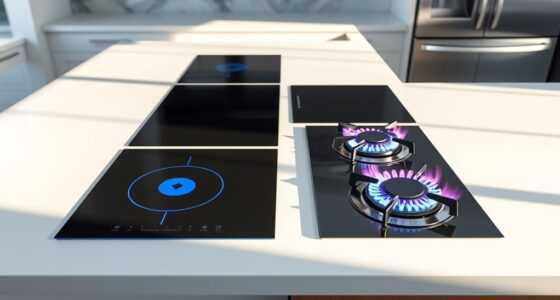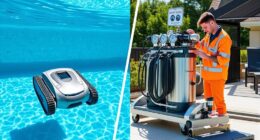If you’re choosing between espresso machines, pump models offer precise control, consistency, and rich crema, ideal for enthusiasts who want quality results. Steam machines are simpler and more affordable but often produce less flavorful shots due to limited pressure and temperature control. Pod systems are super convenient with quick, easy brewing, but lack the customization that serious espresso lovers seek. To find the best fit for your needs, explore the details behind each option.
Key Takeaways
- Pump espresso machines use high-pressure water (around 9 bars) for authentic, rich espresso with crema, offering better control and consistency.
- Steam espresso machines operate at low pressure (about 1.5 bars), producing less crema and often resulting in burnt or over-extracted flavors.
- Pod machines provide quick, convenient brewing with minimal user effort but offer limited control and higher ongoing costs for capsules.
- Pump machines tend to have higher initial investment but deliver superior espresso quality and durability; steam and pod systems are simpler and more affordable.
- Modern pump machines feature advanced controls like PID temperature and pressure profiling, enhancing shot quality compared to steam or pod options.
How Pump Espresso Machines Operate and Their Benefits
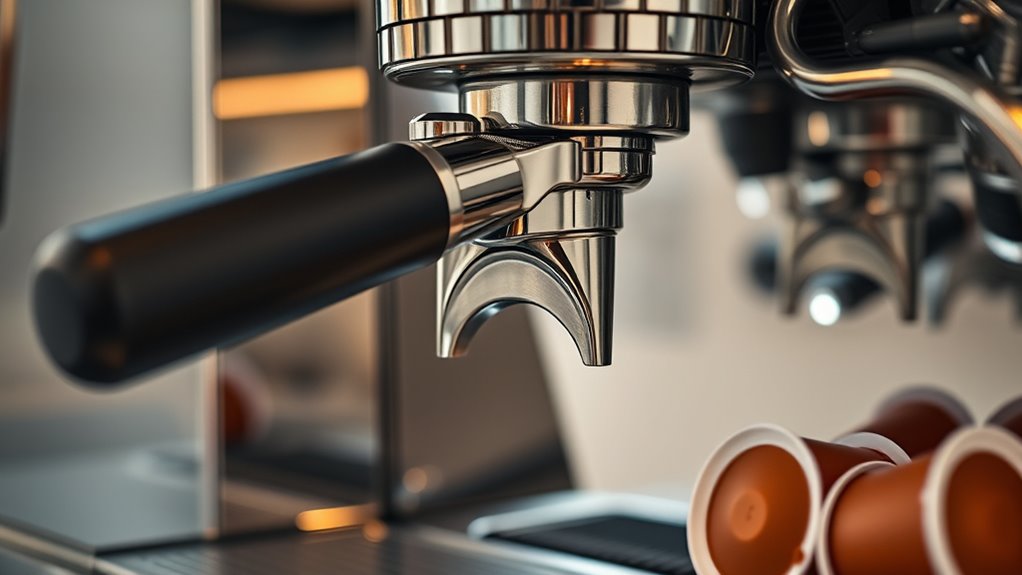
Pump espresso machines operate by using an electric pump to force hot water through finely ground coffee at a pressure of over 9 bars. This high water pressure is vital for ideal extraction, pulling out rich flavors and creating a thick layer of crema on top. With precise temperature control, these machines guarantee consistent brewing conditions, enhancing the overall flavor and aroma of your espresso. Whether you choose a semi-automatic or automatic model, the pump mechanism allows you to customize brewing parameters for tailored results. The consistent pressure and temperature help deliver a full-bodied shot with vibrant flavor. Thanks to these features, pump espresso machines produce authentic, café-quality espresso with excellent crema, satisfying both casual drinkers and connoisseurs alike. Additionally, the suction power of pump machines ensures thorough extraction and efficient brewing performance. Understanding the resources and tools available can further improve your brewing experience by helping you select the right equipment and techniques. Modern pump espresso machines often incorporate advanced technology that allows for more consistent results and ease of use, making them a popular choice for home baristas. Moreover, the maintenance requirements of these machines are relatively straightforward, ensuring longevity and optimal performance over time.
The Mechanics Behind Steam Espresso Machines and Their Limitations

Steam espresso machines use boiling water to generate steam that pushes water through coffee grounds at low pressure, usually around 1.5 bars. This limited pressure and high-temperature operation often lead to inconsistent shots with less crema and more burnt flavors. Because of these mechanics, they face challenges in controlling temperature and pressure, impacting overall espresso quality.
Steam Pressure Constraints
Have you ever wondered why steam espresso machines struggle to produce the same quality as pump-driven models? The key lies in steam pressure, which is limited to about 1.5 bars, far below the 9 bars needed for proper espresso extraction. This low pressure results in insufficient high-pressure flow, making it hard to achieve consistent brewing and *ideal* flavor profile. Additionally, the boiler temperature is often near or above boiling point, leading to over-extraction and bitter flavors. The limited steam pressure also means less crema quality and uneven extraction, which affects the overall espresso taste. Because of these constraints, steam machines can’t reliably deliver the brewing consistency required for a true, well-balanced espresso shot. Environmental considerations play a role in how these machines operate and their impact on *sustainability*. Moreover, the design limitations related to pressure constraints hinder these machines from fully replicating the extraction process of commercial-grade espresso machines. A deeper understanding of home improvement principles highlights the importance of choosing equipment that meets specific needs and environmental standards. For instance, technological advancements continue to push the boundaries of what steam machines can achieve, but they still face fundamental pressure limitations. Additionally, ongoing research into materials and design may help overcome some of these inherent restrictions in the future.
Temperature Control Challenges
Ever wonder why steam espresso machines struggle to deliver consistent shot quality? Their limited temperature regulation hampers control over water temperature, affecting brewing dynamics. Because they rely on a single boiler, inconsistent water temperature causes high temperature fluctuations during brewing. This variability impacts shot quality, making it difficult to fine-tune brewing parameters. The table below illustrates this challenge:
| Aspect | Impact | Result |
|---|---|---|
| Water temperature control | Inconsistent water flow | Over-extraction, bitterness |
| Brewing dynamics | Unpredictable pressure, temp | Less crema, uneven flavor |
| High temperature fluctuations | Unstable brewing environment | Acidic, imbalanced taste |
| Precise control | Limited adjustment ability | Variability in shot quality |
Without precise temperature control, achieving consistent espresso is a challenge. Additionally, understanding the mechanics behind steam espresso machines can help identify ways to improve temperature stability. Incorporating digital temperature sensors and advanced control systems can mitigate some of these issues and enhance brewing consistency. Implementing proper maintenance procedures is also essential for optimal machine performance and shot quality. Moreover, integrating Kia Tuning principles such as ECU remapping and suspension upgrades can be analogous to fine-tuning espresso machines for better control and performance. Recognizing the importance of temperature stability can lead to innovations that significantly improve espresso quality and consistency.
Impact on Espresso Quality
Why do espresso shots from steam machines often fall short of the rich, complex flavors you’d expect? It’s mainly due to pressure and extraction issues. Steam machines operate at around 1.5 bars, much lower than the 9 bars needed for proper extraction, which hampers crema formation and results in a thinner body. The high temperature near boiling can cause over-extraction and burnt flavors, reducing overall brew quality. Limited control over pressure and temperature leads to inconsistent shots and variable flavor profiles. The absence of precise pressure profiling prevents ideal extraction, affecting crema and flavor richness. As a result, steam machines struggle to deliver the same depth, consistency, and control found in pump-driven machines, ultimately impacting the quality of your espresso. Pressure Control is crucial for achieving optimal extraction and flavor balance, and advancements in pressure profiling technology can significantly improve shot quality. Additionally, the lack of advanced control systems in steam machines further limits their ability to adapt to different beans and roast levels, which affects flavor extraction. Incorporating modern brewing technology and digital controls could help overcome some of these limitations and elevate the espresso experience.
The Convenience and Design of Pod Espresso Systems

Pod espresso systems offer unmatched convenience through their simple, one-touch operation, making it easy to brew a fresh shot of espresso in seconds. Their compact design saves counter space, perfect for small kitchens or offices. The brewing process is straightforward, using pre-packaged capsules that eliminate the need for grinding or tamping. These machines feature user-friendly interfaces, often with automatic cleaning cycles that reduce maintenance. The quick operation means you can enjoy espresso without hassle. Additionally, their energy efficiency helps reduce electricity consumption during operation. Many models also incorporate compact and ergonomic designs, making them suitable for various kitchen setups and easy to store when not in use. Incorporating aesthetic design elements can also enhance the overall look of your kitchen environment.
Comparing Brew Quality: Pressure, Temperature, and Extraction
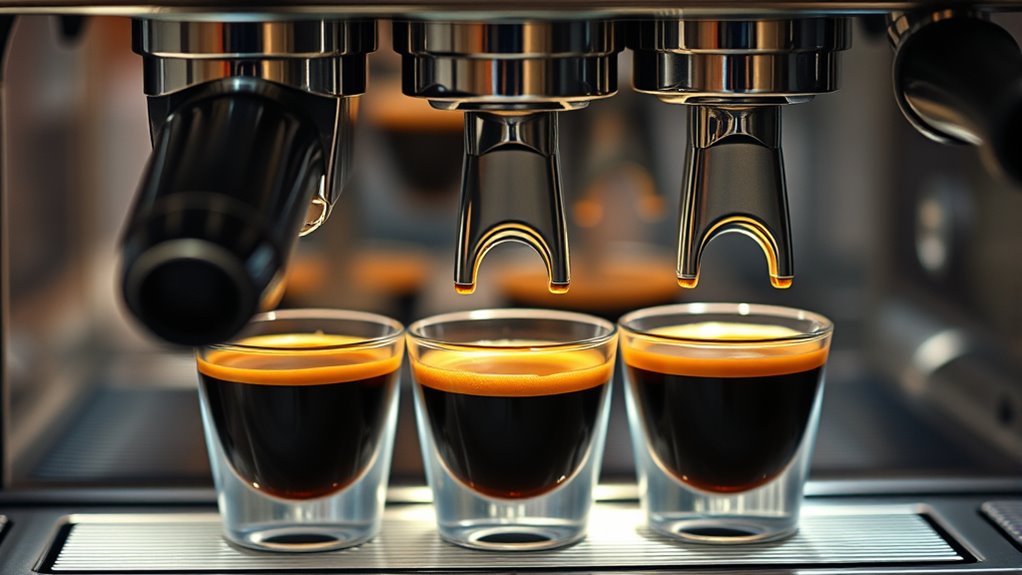
The quality of your espresso heavily depends on precise control of pressure, temperature, and extraction process. Pump machines operate at around 9 bars of pressure, vital for proper extraction and forming a rich crema, which enhances flavor and visual appeal. Consistent temperature, usually around 200°F, guarantees ideal extraction, balancing flavor without over-extraction that causes bitterness. Too high pressure or temperature can lead to over-extraction, resulting in burnt or sour tastes, while inadequate pressure produces weak, underdeveloped espresso. The high pressure in pump machines allows for more consistent extraction, delivering a richer, more flavorful brew with better crema. Variations in pressure and temperature greatly impact flavor profile, crema quality, and overall brew strength, making precise control indispensable for achieving high-quality espresso.
Control and Automation: From Manual to Fully Automatic
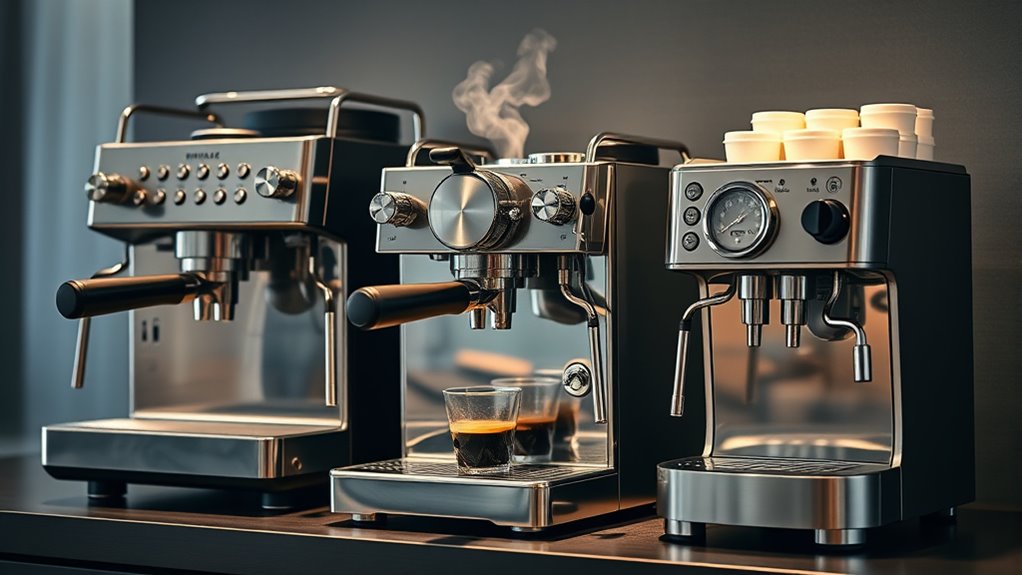
You can choose between manual machines that give you full control or fully automatic ones that simplify the process with the push of a button. Adjusting brew parameters like pressure and temperature lets you customize each shot, but it requires some skill. As automation increases, your involvement decreases, making consistency and speed easier to achieve.
Manual vs. Automated Operations
Manual espresso machines demand hands-on effort, giving you full control over grinding, tamping, and shot timing, which allows for maximum customization. With manual operation, you manage steam pressure and control over extraction, relying on your barista skills to perfect each shot. Semi-automatic machines automate water flow with a button, blending control with convenience, but you still start and stop the shot manually. Fully automatic espresso machines handle the entire process, including water volume and timing, with minimal user intervention, ensuring consistent results. Pump-driven systems in automatic models provide reliable pressure, while super-automatic machines go further with built-in grinders and programmable features for one-touch operation. The level of automation affects your skill requirements, from hands-on manual to effortless fully automatic brewing.
Adjusting Brew Parameters
Ever wondered how different espresso machines let you tweak brew parameters to achieve your ideal shot? With manual machines, you control every detail—pressure, temperature, grind size, and shot timing—offering maximum customization. Semi-automatic and automatic models introduce programming options, letting you set brew volume, pressure profiles, and shot duration for consistency. Fully automatic and super-automatic machines take it further, managing grind, dose, tamping, and extraction automatically via digital interfaces. Modern pump machines often feature PID temperature control and pressure profiling, allowing precise adjustments to optimize flavor. Whether you prefer manual control or automatic convenience, understanding how to adjust these brew parameters is key. Here’s a quick look:
| Control Type | Key Features |
|---|---|
| Manual | User controls pressure, time, temp |
| Semi-Automatic | Programmable brew volume, pressure |
| Fully Automatic | Auto grind, dose, tamping, extraction |
| Pod | Standardized, limited adjustments |
User Skill Requirements
As espresso machines become more automated, the skill required to operate them decreases markedly, making brewing accessible to a wider range of users. Manual machines like semi-automatic models demand user skill for controlling grind size, tamping, shot timing, and pressure adjustments. Pump-driven machines with automation features allow you to customize pressure profiles and temperature settings, but still require some control knowledge. Steam espresso machines typically lack advanced controls, relying on your experience to manage water temperature and pressure manually. Fully automatic and super-automatic machines handle grinding, dosing, tamping, and shot timing automatically, substantially reducing user skill requirements. Pod machines offer the highest level of automation, needing only capsule insertion and a button press, with little to no control over brewing variables.
Cost, Maintenance, and Durability of Different Machine Types

When comparing different types of espresso machines, cost, maintenance, and durability vary considerably. Pump machines often cost between $200 and several thousand dollars, with higher prices offering advanced features. They require regular maintenance like backflushing and descaling to guarantee longevity. Steam machines are more affordable, usually under $200, and are simpler to clean but may need frequent steam wand upkeep. Pod espresso machines have lower upfront costs and minimal maintenance but may incur higher long-term expenses due to capsule replacements. Their durability depends on internal quality, often shorter than pump machines. Here’s a quick comparison:
| Machine Type | Cost | Maintenance | Durability |
|---|---|---|---|
| Pump machine | $200–$3000+ | Regular (backflushing) | Over 10 years with care |
| Steam machine | <$200 | Simple cleaning | Few years, shorter lifespan |
| Pod espresso machine | Low initial, higher long-term | Minimal cleaning | Limited, depends on parts |
Suitability for Different Users: From Enthusiasts to Casual Drinkers

Choosing the right espresso machine depends heavily on your experience level, preferences, and how much effort you’re willing to invest. If you’re an enthusiast, pump espresso machines with precise control and customization are ideal for crafting high-end espresso shots. Casual drinkers or beginners often prefer pod machines for their convenience and minimal learning curve, making brewing quick and easy. Budget-conscious users may opt for steam espresso machines, accepting some compromise in quality for affordability. Your user expertise, desired control, and willingness to invest time or money directly influence the best choice.
- Pump espresso machines offer high-end espresso and precision control for serious enthusiasts
- Pod machines provide convenience for casual drinkers with minimal effort
- Affordable options like steam machines suit budget-focused users seeking simplicity
Making the Right Choice: Factors to Consider When Selecting an Espresso Machine

Selecting the right espresso machine involves carefully weighing several key factors to guarantee it matches your needs and expectations. Consider your budget: pump machines typically cost more but offer better control over pressure and temperature, producing higher-quality espresso. Think about your skill level and desired customization—semi-automatic and automatic pump machines require more involvement, while steam and pod systems are simpler. Long-term costs, including maintenance and consumables like capsules or filters, also matter. Your preference for espresso quality and consistency is vital—pump machines usually deliver richer crema. Ultimately, decide if you want convenience or control. Pump machines excel in quality and customization, whereas pod machines prioritize quick, easy brewing.
| Factor | Pros | Considerations |
|---|---|---|
| Pump machines | Superior control, quality | Higher cost, skill needed |
| Water use | Consistent temperature and pressure | Maintenance requirements |
| Ease of use | Quick brewing, minimal effort | Less control for enthusiasts |
| Consumables | Ongoing expenses | Cost of capsules or filters |
| Long-term costs | Investment in durability | Maintenance and replacements |
Frequently Asked Questions
Is a Steam Espresso Machine Better Than a Pump Espresso Machine?
You might wonder if a steam espresso machine beats a pump one. While steam models are cheaper and simpler, they often produce less authentic espresso with weaker crema due to lower pressure. Pump machines give you more control over pressure and temperature, resulting in richer, more balanced espresso. Overall, for better quality and consistency, a pump espresso machine is usually the smarter choice, especially if you’re serious about your coffee.
What Is Considered the Best Espresso Machine?
You’re asking what the best espresso machine is, and it depends on your preferences and budget. Generally, high-end pump machines like the La Marzocco GS3 or Speedster are considered top-tier because they offer precise temperature control, durability, and professional-grade components. If you want cafe-quality shots at home, look for models with features like PID regulation and dual boilers. For beginners, options like Breville or Lelit provide great value and control.
What Are the Three Types of Espresso Machines?
You might think all espresso machines work the same, but there are three main types. Pump machines use an electric pump to create high pressure for rich extraction. Steam machines rely on steam pressure from a boiler, offering simpler operation. Pod machines use pre-packaged capsules, providing convenience. Each type balances control, cost, and quality differently, so understanding these differences helps you choose the right one for your brewing style.
Should I Get a Nespresso or Espresso Machine?
You’re deciding between a Nespresso and a traditional espresso machine. If you want quick, easy coffee with minimal fuss, a Nespresso suits you. But if you prioritize control over brewing variables and enjoy customizing your espresso, a traditional pump espresso machine is better. Consider your budget, how much effort you’re willing to put in, and whether convenience or control matters most to you when making your choice.
Conclusion
Choosing the right espresso machine depends on your preferences and lifestyle. Did you know that nearly 60% of home baristas prefer pump machines for their balance of control and quality? Whether you’re after professional-level pressure, convenience, or affordability, understanding each type helps you make an informed decision. Ultimately, investing in the right machine enhances your coffee experience and keeps you energized, whether you’re brewing for a quick pick-me-up or crafting espresso masterpieces at home.

